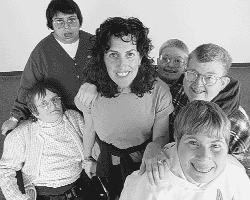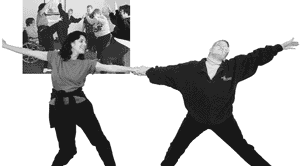"A Room Full of Roller Coasters"
Visiting Instructor Karen Kaufmann teaches dance for people with disabilities
by Maria Healey
|
 |
| Visiting Instructor Karen Kaufmann (center) and her dance students. |
During the last week of classes before Thanksgiving, in the ballet studio of the Performing Arts and Radio/Television Center, a dance class becomes a room full of turkeys. UM Visiting Dance Instructor Karen Kaufmann has just directed her students to move like the big, generous birds. Men and women ranging in age from eighteen to fifty now create a spectrum of motion as varied as their attire, which runs from leotards to jeans, sweats to suits, a red kerchief bound around a head. With broad, percussive swings of the arms, some cradle invisible bounties while others sway their hands, march in place, slide, spin and, of course, waddle. The dancers perform a rich and surprising matrix of movement.
The class is called Teaching Dance for the Disabled, a course developed by Kaufmann in 1992 as a way of training her University dance students in teaching skills. Offered each fall, the class welcomes twenty participants: some are developmentally disabled, some suffer from cerebral palsy, some have been in debilitating accidents. Outside this classroom, these people struggle to navigate a world that does not make much room for disability. What they share here in the immense studio is movement.
Many dance alone. Hands rise in all fashions, out to the sides, high in the air, arcing in circles overhead, stretching skyward, fingers twitching. A man in a wheelchair named Lee waves his hands back and forth. Becka, a tall, vision-impaired woman, steps away from the group and dances in small circles the length of the studio. Barbara marches in groovy triumph beside the accompanist, bowing repeatedly to the young man after each piece. Dick, arms raised, likes the feeling of leaving his body, becoming "a tree, a bird or a goose." Kaufmann is pleased. The point of the class, she says, watching the students lose themselves in dance, is that they learn "not what's right in movement, but their own movement.
"Just about everybody can move in some way," she says. "I think people learn a lot about themselves through movement. They express themselves through movement and learn about the world, who they are, how they feel."
Having studied undergraduate dance at Hampshire College in Amherst, Massachusetts, Kaufmann came to UM in the late seventies, leaving briefly to pursue graduate studies at Antioch College in Ohio. Since then the dancer, with colleague Amy Ragsdale, co-founded and now co-directs the Montana Transport Company (Mo-Trans), UM's professional dance troupe, which last year performed Kaufmann's Dancing Waters in Finland, invited by the Dance and the Child International Conference.
Kaufmann's passion for bringing dance to a variety of populations led her in the eighties to Missoula public schools, where she taught a number of special education classes. There she faced a "creative challenge to find the ways a student can adapt and change and vary." This challenge inspired her to teach her University students how to introduce creative movement to diverse populations.

A partnership with Very Special Arts Montana, which enrolls the students with disabilities and provides transportation, Teaching Dance for the Disabled is a required course for UM dance students who want to teach. But Kaufmann also gets calls from all over campus--from wildlife biologists, for example, who wonder if this is something they can do. "And it always is," she says. "Anybody can walk in, having never had a dance class or having had years [of classes]."
In June 1997, professionalism in teaching and performance came together in A Step Forward. Presented on PBS, the short documentary, made by Gus Chambers of UM's Broadcast Media Center, follows the students through classes and into rehearsals, culminating in a public performance for a full house at Missoula's Front Street Theatre.
These days, Kaufmann divides her time between teaching classes and overseeing the teaching track, which educates dancers to work with several nontraditional dance populations, such as children, University beginners and the developmentally disabled.
"It's another important part of my work," she says. "To get dance to as many different populations as I can, to get more educators to realize the value of movement in the classroom as a learning tool.
"The key is in adapting dance to whatever population you have. Rather than expecting students to be at the level I want, it's up to me to use the language I know along with what they know and turn it into [performance]. It became clear that if I used my creativity, perceiving both consciously and unconsciously, subtly and instinctively, what they can do and how I could progress them, I could actually make something happen that nobody thought could happen, not that person, not me, not the general population."
"Karen's really skilled at teaching different populations," says Ragsdale, UM dance professor and choreographer. "She's flexible and ad libs on her feet. You have to do that, [teaching] the developmentally disabled. They're unpredictable, [taking instruction] in ways you don't expect. That ability to turn 180 degrees and go in another direction, because that's the way [an instruction] has been interpreted--Karen's very game for that kind of challenge."
Just as Kaufmann and her student instructors cultivate dance in students with disabilities, they also learn in this class new ways of dancing themselves. Delphine Rose, a senior who has taken the class twice, finds the work inspiring. "I love being a dancer, having seen these beautiful people dance," she says. "Professional dancers spend so much time on technique and getting things perfect. Because [the students with disabilities] don't have the full function of their bodies, they find other ways to create a movement. For people like me, who've been conditioned to move in a certain way, it's a real eye-opener. I think, 'Oh, I can move this way.' They just really dance with their hearts."
"They embody something unaffected," Kaufmann says of these students. "There's an openness, an honesty with themselves, about where they're at, what they can do, and if something triggers their imagination or their creativity, they're very spontaneous."
As a closing exercise in the ballet studio, Kaufmann suggests that the dancers demonstrate a shape with their bodies, first a straight line, then a circle, finally a spiral. She hands out colored streamers, and the students cross the studio, dipping at the knees, whirling their arms, twirling the orange, purple and green fabric. Someone calls out that she feels like a roller coaster, and Kaufmann agrees. "A whole room full of roller coasters," she says, joining in the parade-like gaiety. Everyone is flushed and grinning.
"This class improves flexibility, coordination and balance," she says. "There's also the creative benefit of the students seeing themselves as having imagination."
Kaufmann looks out over the room, regarding the colorful roller coasters. "In a way, teaching this class has made me understand movement better, because it brings [dance] back to a very basic level. Some dancers think so much in terms of complex patterns. There's so much beauty in simplicity."
Maria Healey, M.F.A. '92, lives in Missoula.


|